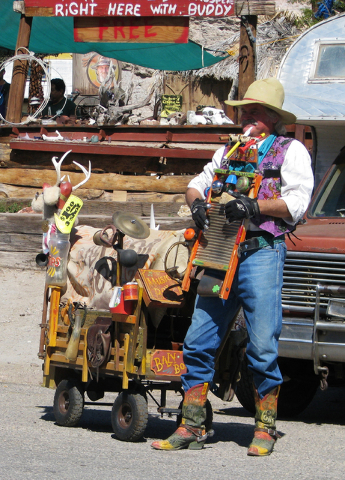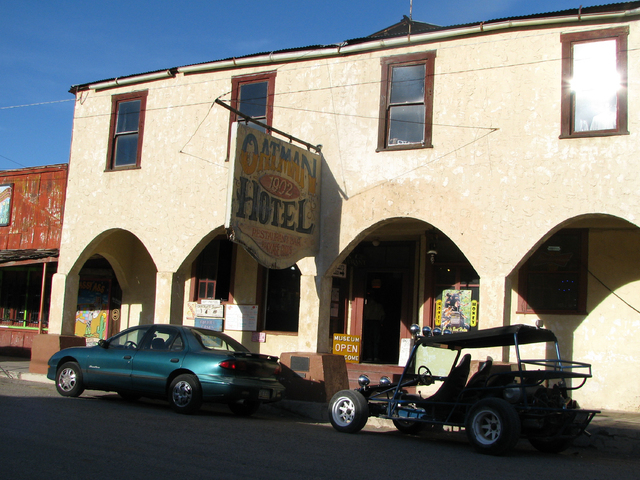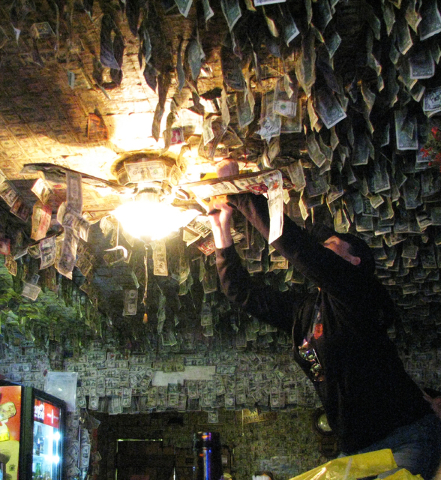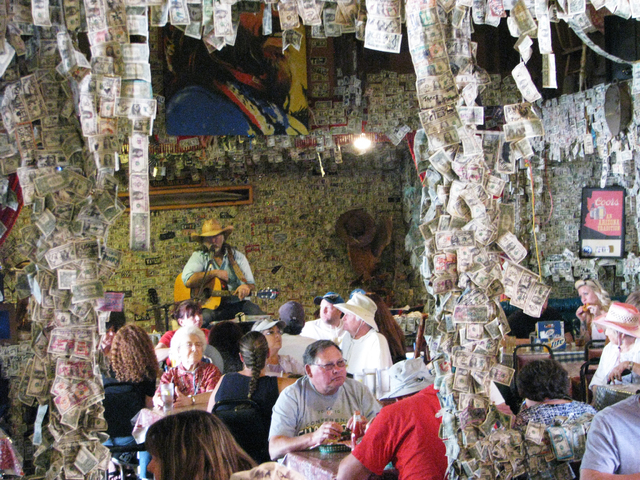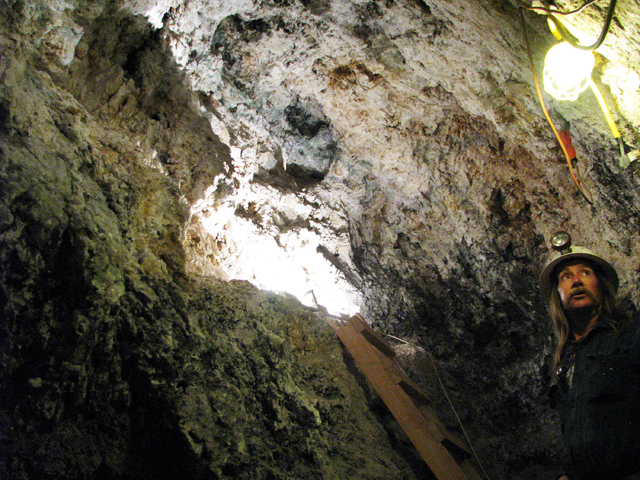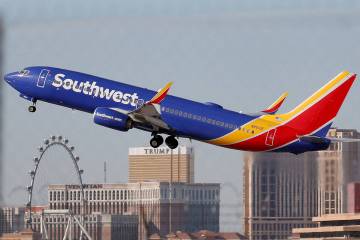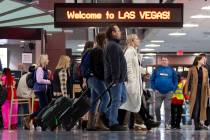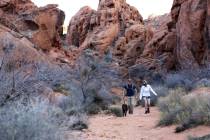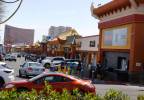Except for gunfights, Oatman, Ariz., is a laid-back and welcoming place
“I’ll give you a tour of the town in my dune buggy,” Jim Quinn said. “Right after I finish my beer.”
As far as I know it was the first beer of the day, and it seemed like a reasonable statement because it was just about closing time in Oatman, Arizona. The beer was going to get hard to find in a few minutes. When the bartender at the Oatman Hotel Bar found out I was writing about the town, she told me I had to talk to Jim Quinn. So far she had been a font of information and good cheer and cold beer on a hot day, so why would I doubt her? I asked where I could find Quinn.
“Oh, he’s at his office,” she said. “Right down there at the second barstool from the end.”
Oatman is just more than two hours away from Las Vegas, but you’d be hard pressed to find two places in the Southwest that are more different. Although both places depend heavily on tourism, the fast pace and nonstop action of Las Vegas is contrasted dramatically with the laconic, easygoing nature of Oatman. Just about any question asked to a local results in a story, a tall tale or a history lesson. Often all three at the same time.
The town sits on the foothills of Arizona’s Black Mountains. Gold put Oatman on the map and Route 66 kept it there. The miners were sent off to other places to dig up metals more valuable to the war effort in World War II, and that combined with a drop in gold prices and a shift of traffic when a new alignment of The Mother Road bypassed the town to the south pretty much turned the place into a ghost town.
When I first visited Oatman 25 years ago, it was still listed as a ghost town on maps. There are quite a few derelict and picturesque buildings and a bit of mining equipment in and near town. Old wooden sidewalks lined both sides of the street. A fire burned much of the town in 1921, but some buildings still are standing from the town’s early days in the first decade of the 20th century. At its peak, Oatman was home to about 3,500 people.
“In the ‘60s there were only about 15 hippies living here,” Quinn told me as his sturdy four-seater buggy bumped over the rough dirt roads of the town. “Now there are about 100 to 120 people living here and 14 union burros. They show up for work at 9 in the morning and leave at 5.”
The burros are the descendants of the ones that worked the mines and were released to the wild when the mines closed. According to Quinn, authorities recently culled the herd to the current 14, including several babies. The town has a symbiotic relationship with the burros. They are one of Oatman’s chief attractions with most of the stores along the single paved street through town selling paper bags of Burro food. Signs admonish visitors not to feed them anything else, particularly people-food or carrots. The young burros have stickers on their foreheads reading “DO NOT FEED ME CARROTS” and all of that probably relates to a sign I saw there years ago that read, “Please do not feed the burros on the sidewalk. They recycle quickly.” I never asked what carrots do to the burro “road apples,” and frankly, in this instance I’m willing to presume ignorance is bliss.
Quinn’s buggy took me past the titular art on Mural Road. It’s a trippy work featuring a figure with outstretched arms and geometric patterns and structures in perspective in mostly browns and blues. Quinn wasn’t sure if those were the only colors used in the work or if those were the only colors that survived a half-century of Arizona sun.
We stopped at the dead end road at the top of the hill near the town’s water tank and Quinn hauled up a football-sized rock and took it to a high fence enclosure near the tank. He hefted it over the fence into what turned out to be a deep mine shaft. The boulder could be heard bouncing for a comically long time. He grabbed my arm and pulled me a few feet to the left.
“You’d better watch out,” he said. “If I didn’t hit him, the guy at the bottom is going to throw it back up here.”
I later learned that some mines were dug straight down, following a vein of gold, while others went horizontal for a while and then straight down. The mine at the top of the hill was several hundred feet deep and the deepest mine in the area was more than 1,000 feet deep. There’s a reason people are told to stay out of abandoned mines.
“Well, that’s that,” Quinn said. “Let’s head down to the mayor’s house for a drink.”
We traversed more winding dirt and bare bedrock roads through the east side of town where most of the people live in a mix of old trailer homes hauled there 40 or 50 years earlier and wooden structures from the town’s earlier years. Snob Hill on the west side of town is where most of the newest homes were built and are lived in by a few folks with money, including the owner of the Oatman Hotel. We parked in front of a structure that was a combination of a mobile home with a wooden structure built on the front, adding a few rooms. A fenced-in porch was in front of that and the entirety of the street side of the home was covered in rusted metal geegaws and signs.
“This is the seventh wonder of Oatman,” Quinn announced proudly. “This is Quinntopia.”
Quinn has owned the place since the 1970s, and at some point he took on the unofficial mantle of mayor. Presumably as long as he holds on to the title without trying to wield any actual power, he’ll be able to keep it. When the hotel closed down its rooms a few years ago he turned his spare rooms into an unofficial bed and breakfast, or in this case, a barbecue and breakfast. His guests enjoy the run of the house and all the privacy a beaded curtain can afford. The accommodations usually include a few meals cooked out in the backyard and a tour of some of the wilder places around town in the buggy.
He is not the only resident to open his home to visitors this way. A polite inquiry to any of the town’s bartenders is likely to lead you to one place or another to hang your hat for a night or two. The only official overnight accommodations in Oatman are a few cabins behind the hotel, including one that is pet friendly. Until a few years ago, you could stay in one of the handful of rooms in the 1902-built hotel with a shared bathroom for the entire hotel. The rooms were mostly removed in a retrofit to stabilize the structure. The building was originally the Drulin Hotel and it is the oldest two-story adobe structure in Mohave County.
Where the rooms once were are now a more open second floor retail space selling antiques and souvenirs of Oatman, Route 66 and Arizona. The single street through Oatman is lined with dozens of restaurants and shops selling souvenirs, leather goods, antiques and Americana.
The only hotel room that remains and can be viewed in the Oatman Hotel is the Clark Gable, Carole Lombard honeymoon suite. An employee keeping an eye on the register near the room told the story of how that happened. She preferred to remain anonymous.
“They got married in Kingman and there were the equivalent of paparazzis waiting for them when the plane landed there,” she said. “Instead of flying back they rented a car and drove back to Hollywood. Clark Gable used to come out here and gamble with the miners so he knew about Oatman. We didn’t have a movie theater out here so they didn’t know who he was and he could have a little anonymity.”
The couple stayed in Room 15 on the evening of March 29, 1939. They were in town for all of about 10 hours before heading on their way. The hotel employee said that the pair returned to town on their anniversary in 1940 and ‘41. Lombard died in a plane crash on Potosi Mountain west of Las Vegas before they could return for a third anniversary.
The restaurant and the bar of the Oatman Hotel have approximately $160,000 of decorations in the form of actual dollars, glued, nailed, stapled, decoupaged and otherwise attached to the walls, ceiling and nearly every other surface.
The locals say the practice began in the mining days, when the miners would stick a dollar on the wall and mark off their drinks on it. Over the years the tradition shifted to just being a way of commemorating a visit to the town.
“I guess I’ve left my mark,” said Debbie Ryan after stapling her addition to the decor just above a ceiling fan over the bar. “This is the first time I’ve done that. I’ve been here before, but I’m just more relaxed this time, more used to the town.”
Ryan was visiting from Mission Viejo, California, with her husband and they had taken a day trip from Laughlin. The route from their home to Laughlin takes four and a half hours, a little longer than the trip to Las Vegas, but they just prefer the laid-back feel of the tri-state area.
“This place is so much fun,” she said. “It’s relaxing and everybody is so friendly. You can get away from it all here”
The owners and operators of the hotel aren’t too worried about someone trying to make off with their decor. It would be a laborious and cumbersome heist and if the shirts and signs for sale in town are to be believed, the place is a bastion of folks willing to exercise their Second Amendment rights.
That isn’t to say the town is crime free; in fact, there are a few gunfights every weekend. A couple of hombres bite the dust like clockwork but generally they sit up, dust themselves off and pass the hat to the adoring crowd.
The Oatman Ghost Rider Gunfighters perform at 1 and 3:30 p.m. on the weekends. When the weather heats up they drop the later performance. They close the street for 15 or 20 minutes and perform comic conflagrations that almost always end in gunplay. The guns fire blanks, which are startlingly loud at close range, but the union burros don’t even flinch anymore.
“I’ve been doing this for four years,” said a cowpoke who goes by the handle Dusty. “Some of the other guys have been doing it 15, 20 and even 35 years. We’re all volunteers and the money we raise goes to help the kids at the Shriners Hospitals.”
Between the gunfights he strolls among the crowd and talks to the tourists, joking with them and poking a little good-natured fun at them. He originally came to Oatman as a tourist and enjoyed the show. When he moved to Kingman to help his ailing mother, he joined up with the gunfighters for the fun and to make a difference.
“I’m retired now, but back in Kentucky I used to be in law enforcement,” Dusty said. “Now I’m a bank robber.”
The philanthropic desperados said that they’ve raised more than $82,000 for the Shriners Hospitals.
Getting away from the hubbub of the city is a big part of the appeal of Oatman, and it still draws new residents and shopkeepers like Crazy Ray, who came to town a year ago.
“I was a diesel mechanic for 30 years and my wife and I came out here from Beaumont, California, so I could do my art,” he said.
Ray’s shop is one of the first you see when you come into town from the Nevada side. He carves, sometimes on bone, and does elaborate designs on T-shirts with a pair of scissors. He charges $15 for most designs if you bring your own shirt and a little more if he provides one. A large sign emblazoned with his face advertises “Crazy Ray’s Crazy Brittle. Flavors so Crazy … They had to call them Crazy twice!”
His friend John George spends a lot of time in the booth strumming away on an old guitar and singing with and without Ray.
“When Ray moved out here he looked like he could use a friend and I decided to hang out with him, even though I don’t like anyone, ” George said with what appeared to be a huge grin. ”I’m not smiling. My lips are too small for my teeth.”
I had come to see Ray because I’d been told that the stacks of small rocks on the roadside that I’d seen on the way to town were his handiwork.
“Oh, the Laughlin snowmen?” he said when asked about the stacks. “Oh, I can tell you all about those.”
He proceeded to launch into a story that explained not only the rocks, but the scrub bushes decorated with ornaments and garlands on the way into town. Actually, he started the story, saw a few people gathering and waved them all into his booth before going back and starting the story back up from the beginning. It was a charming tall tale and when it was done a few people hung around to examine his wares and see about getting a shirt cut.
There is some on-street parking in town and a dirt lot at the south end. On the busiest days visitors can end up parking along the street quite a ways out of town. The business is hopping, particularly on the weekends from 9 a.m. to about 3 p.m., when the crowds begin to drift away. They don’t actually roll up the sidewalks at 5 p.m. when the shops close, but it’s very close. Tables of merchandise are hauled into the shops and by 5 the empty streets make the town resemble the ghost town it once truly was. The bar at the hotel closes at 6 and the last place to shut its doors is Judy’s Saloon near the top of the main road.
“Oh, we close when we close,” said the bartender. “Sometimes we close at 7. Tonight we’re probably closing up around 8. You should have been here last night, we were having a good ol’ time until about 2 in the morning. You want some cake? We just had a birthday party. There’s some sandwiches over there, too.”
A half-dozen people were seated at the bar, enjoying the twilight, the company and the homemade birthday cake. If the stranger in their midst bothered them, they certainly didn’t let on.
The northern route out of town twists and turns through the Black Mountains to the Sitgreaves Pass, elevation 3,523 feet. This was the most difficult part of Route 66 and the challenge it presented to the less complex cars of the era were among the reasons the stretch, and Oatman, were eventually bypassed. Modern cars shouldn’t have a problem traversing the road, but the dizzying drops and miles of switchbacks might be unnerving for some drivers. The sights are breathtaking and worth the trip, even if it’s just to go through and come back again.
One of the first sights you pass heading out of town is Goldroad. Twenty-five years ago it was a cluster of decaying fragments of old stone and concrete buildings hidden among the boulders. Then a combination of rising prices and modern technology made it a viable enterprise again and a large mining operation was built. In recent years, fortune has turned the other direction for Goldroad and the mine was shuttered, creating a modern ghost town alongside the ruins of the earlier one.
Russ Touve was one of the men who worked that mine, coming to it in 1997. Now he and Mike Van Stratten spend their weekends taking tourists back into the mountain and back in time. They give tours on the weekend of the Homestake Mine a few miles out of town. The mine is accessed by Silver Creek Road, a wide, well-maintained dirt road just outside of town to the north. There are a few mines along that road with warning signs of varying degrees of threat admonishing potential trespassers to beware.
“It’s easy to find the road to Homestake Mine,” Touve said. “It’s the only one with a sign that has ‘Welcome’ on it.”
The tours go about 200 feet vertically into a mountain with a string of lights and a ventilation pipe running from the front. Short railroad ties used to hold a track that the ore car ran along. The rails are long gone, either to another mine or salvaged for the war effort during World War II.
“If you can, you tunnel into the hill and mine up on the vein, then you build an ore chute and let gravity bring in down,” Van Stratten said. “There was no electricity out here when these old mines were dug, so that was the best way to do it.”
During the week Van Stratten does lath and plaster work and Touve “does whatever’s next.”
“I’m sort of the Oatman handyman,” Touve said.”
Both have mined the area but they say the Homestake Mine is pretty well tapped out. About five years ago they started doing the tours, cleaning up the area, fixing up the restroom and making a gift shop with displays of interesting geological specimens from the area and around the world. The pair is proud to show off the mine.
“This mine hasn’t put out a lot of gold, but it’s been the first mine that a lot of people have been in,” Van Stratten said. “Plus, there’s the view that we’ve had here for the last 20 years. That has been magical.”
It was Quinn, at the end of his tour of town that introduced me to the pair who had just come back into town and were enjoying the cooling air and the magnificent moonrise.
I told Quinn I’d probably see him the next day, but he told me he wouldn’t be coming into the office the next day.
“NASCAR,” he said.
If You Go Getting there: There are two routes to Oatman that are nearly the same distance. The Nevada road, which passes through Searchlight, Laughlin and Bullhead City, Arizona, is 127 miles. Take U.S. Highway 95 South and turn east at Nevada State Route 163, south at Arizona State Route 95 and east at Boundary Cone Road and continue to Oatman. The Arizona road passes over the Mike O'Callaghan-Pat Tillman Memorial Bridge, through the edge of Kingman, Arizona, and over Sitgreaves Pass. Take U.S. Highway 93 south to Interstate 40 and turn south. Take exit 44 and turn right on Route 66 and left on Oatman Highway Road and continue to Oatman. Lodging: Oatman is about 30 minutes from Needles, California, and 45 minutes from Kingman and Laughlin. Inexpensive and reasonable hotel rooms can be found in all three. Kingman has several interesting sights to recommend it. Laughlin has gaming, entertainment, many restaurants, nightlife and the riverwalk along the casinos and the Colorado River. Needles also is along old Route 66 and has some of the classic architecture of that era, if a little faded and run down.







